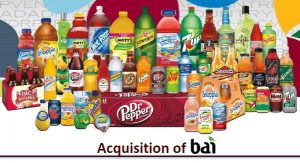By Jonathan Hodson-Walker

Overview
Dr Pepper Snapple Group, Inc. (Dr Pepper) announced the acquisition of Bai Brands, LLC (Bai) for $1.7 billion on Tuesday 11/22/2016. This is an exceptional price even for the alternative beverage market where valuations have been escalating rapidly in recent years. The $1.7 billion reported price is 7.4x estimated 2016 Bai revenue of $231 million. This multiple is more typical of an EBITDA multiple rather than a revenue multiple! As with most exceptional deals, there are interesting circumstances behind the headline numbers. This deal value was driven by:
- Strong growth potential in large market opportunity,
- Scarcity value – few alternative potentially billion dollar “white space” product opportunities,
- Strategic dependency,
- Tax advantaged acquisition structure (24% of value), and
- Low cost of capital (less than 3%).
Growth, Growth, Growth
Bai has grown from $16 million of revenue in 2013 to an expected $231 million in 2016, which represents a CAGR of 143%. The Bai business is expected to more than double over the next two years to over $460 million in 2018. Dr Pepper’s branded carbonated soft drink volume was flat from 2014 to 2015 and over that time, Dr Pepper’s non-carbonated beverage volume grew by 6% with the highest volume growth coming from the water category (Bai and others), which was up 22% over the period (Dr Pepper 2015 10-K). With essentially no change in volume, the Dr Pepper revenue growth in 2015 was achieved through price increases and favorable sales mix changes. For Dr Pepper, as a public consumer company with $6.3 billion in revenue, $1.4 billion in EBITDA and flat case volume, selected M&A is an essential strategy for achieving meaningful revenue growth.
Scarcity Value; Billion Dollar Potential
Bai is expected to account for $425 million in revenue to Dr Pepper for 2017. That is a significant and growing revenue stream for Dr Pepper that could be 10% of total revenue in several years and potentially a billion dollar business over time. There are very few brands that can succeed to that extent in the CPG market and such scarcity value commands a premium in the M&A context.
Strategic Dependency
Approximately 65% of Bai’s revenue is distributed through Dr Pepper. The counter point to the scarcity value and growth potential of Bai is that it would be a significant negative if Dr Pepper were to lose the Bai revenue through a competitor purchasing the business. Not only would the revenue, cash flow and growth be removed from Dr Pepper’s income statement, but a large competitor would gain dominance of a relatively new, highly attractive, large market opportunity.
Tax Advantages: Asset Purchase not a Stock Purchase
Dr Pepper attributed $400 million of the purchase price to “tax benefits”. Put another way, that amount is the present value of tax payments that Dr Pepper expects to avoid having to pay as a result of the “tax shield” arising from the asset purchase form of transaction. The asset purchase was made possible because Bai is a limited liability company (LLC) that is a pass through entity for tax purposes. In an asset purchase transaction, the purchaser is required to allocate the price paid across the assets purchased and then depreciate or amortize those assets for tax purposes over proscribed periods of time. Any value that cannot be assigned to a specific asset is “goodwill” and goodwill is required to be amortized over 15 years for tax purposes. Bai is an “asset light” business and a substantial portion of the purchase price is likely to be goodwill. Many venture funded companies are organized as “C-corporations,” entities that pay taxes rather than pass through tax payment obligations. Without getting into the details of inside tax basis vs. outside tax basis, or exceptions, the key takeaway is that goodwill cannot be written up in line with the deal value in a stock purchase transaction and so future tax shields from goodwill amortization are not available. According to Dr Pepper, this structural feature alone accounted for $400 million, or 24% of the $1.7 billion purchase price.
Low Cost of Capital – Lower Hurdle Rate for Earnings Accretion Allows for Higher Value to be Paid
On a fundamental level, if the earnings yield of an acquisition is higher than the acquiring company’s cost of capital, the transaction will be “accretive” to the acquiring company’s earnings and additive to value. Despite bond market yields increasing over recent weeks, interest rates are still close to all-time historical lows and large companies can borrow at very low rates. With a very low cost of capital, a large company can drive up the price of an acquisition until the cash flow from an acquired company equals the interest paid to finance the acquisition. Future growth in the acquired business will generate cash flow that exceeds the interest cost and the acquisition will become accretive to overall earnings. Dr Pepper announced that the entire Bai acquisition is being financed with new unsecured notes and $150 million of commercial paper (short term, low cost financing), with a total incremental interest cost of approximately $50 million. This means the average interest rate that Dr Pepper is paying to finance the Bai acquisition is 2.94%. The incremental operating income from Bai in 2017 is expected to be $43 million, therefore slightly dilutive to earnings, and the Bai business is expected to be accretive to earnings in 2018 – understandable with the expected growth in Bai sales.

